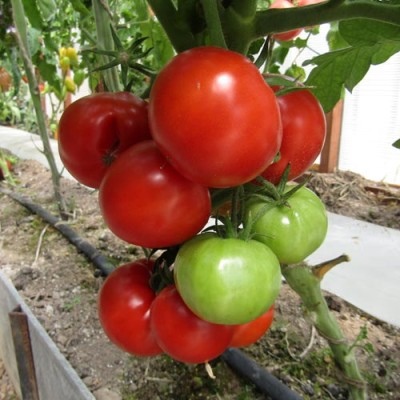
- Category: hybrid
- Growth type: determinant
- Appointment: universal
- Ripening period: ultra early
- Ripening time, days: 90-93
- Growing conditions: for open ground, for film greenhouses
- Transportability: Yes
- Bush size: undersized
- Bush height, cm: 70-80
- Bush characteristic: powerful
Tomatoes are grown in all household plots, dachas and vegetable gardens. Everyone tries to plant an unpretentious variety, which is characterized by abundant harvests, tasty and fleshy tomatoes, and also does not take up much space on the site. One of these is the early ripening variety Alenka.
Breeding history
This standard type of tomato was bred by Russian breeders relatively recently, but it quickly attracted the attention of gardeners and farmers. The main task of the scientists was to create a tomato variety that will grow in any climatic conditions, regardless of whether it is a greenhouse or open ground.
Description of the variety
The type of tomato Alenka is a crop that is compact, low-growing bushes with a sufficiently powerful stem that can withstand a large number of tomatoes during the period of active ripening and fruiting. The root system is rather weak, therefore the growth of the bushes does not exceed 60-80 cm. The bushes are undersized, therefore they do not require fixing supports.
The main qualities of the fruit
Tomatoes have the correct rounded shape and considerable weight - on average, a tomato weighs 200-250 grams. The color of the tomatoes is pink, and the skin is dense and perfectly smooth, completely not prone to cracking, which guarantees excellent transportation without large losses.
Taste characteristics
The taste qualities of Alenka tomatoes are pronounced. The pulp is juicy and soft, and the taste is pleasant, with a detectable sweetness when fully ripe. Tomato pulp is rich in potassium, magnesium, iron and zinc salts. This type of tomato is a universal one, since it is suitable not only for eating fresh, but also for canning whole, for salads and juices.
Ripening and fruiting
The variety is ultra-early, it takes 90-93 days to ripen, regardless of weather conditions. Ripening of tomatoes occurs evenly and simultaneously. Despite the hybridity of the bushes, tomatoes hold up well without crumbling.
Yield
A variety with high yields. On average, with proper agricultural technology, up to 5 kg of tomatoes can be harvested from one bush, and 13-15 kg from 1 m2.
The timing of planting seedlings and planting in the ground
The timing of planting seeds for seedlings depends on the climatic conditions where the culture will grow. On average, planting occurs from early March to mid-April. Ample lighting is required for healthy seedling growth. Seedlings love light for 12-14 hours a day, so artificial lighting is indispensable.
In order not to cause stress in the plant, 7-10 days before planting in open ground, the bushes should be a little accustomed to fresh air and the climate in general. To do this, the seedlings are daily taken out into the fresh air, and the day before planting in the soil, they remain outside for 24 hours for adaptation. Seedlings are planted in the ground from mid-May to 10-15 June.

Growing tomato seedlings is an extremely important process, because it largely depends on whether the gardener will be able to harvest at all. All aspects must be taken into account, from seedbed preparation to planting in the ground.
Landing scheme
It is recommended to plant bushes in open ground in the evening or in cloudy weather.No more than 5 bushes are placed per 1 m2. The planting scheme is as follows: 40 (distance between bushes) x 60 (distance between rows) cm. Formation into one stem is not required.

Growing and care
Due to their absolute unpretentiousness, tomatoes can be grown in almost any weather conditions in open ground or film greenhouses. Before planting, the soil is fed with a complex of mineral fertilizers, and it is recommended to add sifted wood ash to each hole. Sowing seeds for Alenka tomato seedlings must be done 50-55 days before planting the bushes in the soil. Planting of seedlings takes place after the threat of the return of spring frosts has passed.




A plant needs different micronutrients at each stage of growth. All fertilizers can be divided into two groups: mineral and organic. Folk remedies are often used: iodine, yeast, bird droppings, eggshells.
It is important to observe the rate and period of feeding. This also applies to folk remedies and organic fertilizers.
Disease and pest resistance
The culture has excellent immunity to many types of diseases, however, it is recommended to carry out preventive measures to prevent late blight, tobacco mosaic, and apical rot. To combat the invasion of pests, an insecticidal preparation will cope. Experienced summer residents recommend the use of a soap solution, which is effective in pest control.


Resistant to adverse weather conditions
This species is completely unpretentious to temperature fluctuations, and also tolerates prolonged heat, while not baking under the scorching sunlight.
Growing regions
Alenka tomatoes can be grown in almost all regions of Russia, including areas with a not very favorable climate.
Review overview
After studying the many reviews of gardeners and farmers growing crops on an industrial scale, certain conclusions can be drawn. The early-ripening variety Alenka is completely non-capricious, does not require special feeding and watering schemes, therefore it can be grown even by inexperienced gardeners.
Most summer residents note the high taste of tomatoes, good and long-term storage after harvest, as well as bountiful harvests. The only drawback, according to some gardeners, is the need for tying, since the bushes often spread along the ground.

























































































